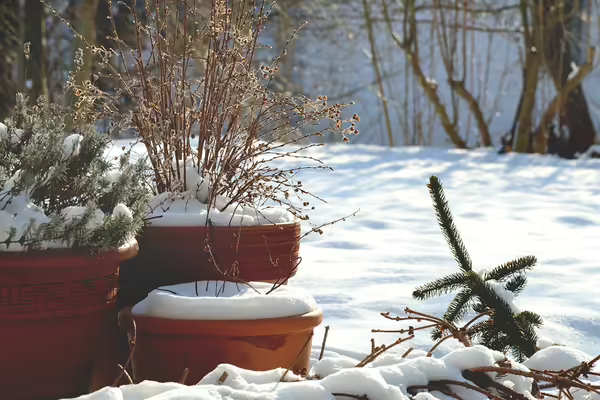
URBANA, Ill. — Perennial plants being overwintered in pots are subjected to much harsher conditions compared to those in the soil. Because of this, they can be damaged and killed. Fortunately, there are some steps to try to get these plants through the winter and enjoy them again come spring.
Why Take Time to Protect Potted Perennial Plants?
So, why take the time to protect potted perennial plants? Most plants’ roots are far less cold-hardy than their above-ground parts. Usually, this isn’t an issue because the soil will insulate the roots and protect them from extreme cold temperatures. While potted plants may be in a growing media, the amount of media is small and will get much colder than soil in a landscape.
Since potted plants’ roots are exposed to colder conditions than those in the ground, it’s a good idea to look for plants that will survive in a hardiness lower than the zone they will grow in. The general rule is to select plants that will survive two zones cooler than where the plant will be growing. For example, central Illinois is zone 5 or 6. Therefore, for that location, consider a plant that is hardy to zone 3 or 4 if planning to overwinter it outdoors in a pot.
Overwintering Perennial Plants in Pots
Explore a few steps that are best for hardy perennials. The following guidelines do not apply to non-hardy plants like geraniums, as those may need to be handled differently.
Before getting pots ready to overwinter, make sure the plants inside are well watered, and check throughout the winter. This is especially important for evergreens to help prevent winter burn. Even after above-ground growth has gone dormant for the year, the roots will continue to take up water. In addition to providing water to the plants, moist growing media will freeze slower than dry media, offering additional protection.
The most common way to overwinter potted perennials is by storing them indoors. Places like an unheated garage, shed, or cool/cold basement can be good locations to place potted perennials for the winter. Many perennials need a cold dormancy to properly bloom and grow, so if a garage or basement is too warm, temperatures should be between 20°F and 45°F; consider elsewhere.
A second option is to sink containers into the ground. By placing the pots in the ground, the surrounding soil can insulate the pot, providing protection from extremely cold temperatures and temperature fluctuations. Additionally, the pots and plants can be mulched to provide additional protection. Once the danger of a hard frost has passed, the pots can be removed from their holes.
Grouping pots together in a protected location. If digging a hole in the ground isn’t an option, or the pot is too large, try grouping pots. Look for an area that doesn’t receive strong winds or too much sunlight, such as the north or east side of a building. Once the pots are clustered, mulch them heavily with straw, leaves, or wood mulch. Once growth resumes in the spring, remove the mulch and return the pots to their rightful place.
For more on overwintering potted plants, check out the Good Growing blog. For questions, contact a local University of Illinois Extension office from the map.
Ken Johnson is an Illinois Extension horticulture educator for Calhoun, Cass, Greene, Morgan, and Scott counties. Gardeners Corner is a quarterly newsletter from gardening experts around the state. Each issue highlights best practices that will make your houseplants, landscape, or garden shine in any season. Join the Gardener’s Corner email list at subscribe for direct access to timely tips.
Photo Caption: Taking steps to properly overwinter potted plants gives new life to an already adored plant just in time for spring. Photo: Adobe Stock.
University of Illinois Extension develops educational programs, extends knowledge, and builds partnerships to support people, communities, and their environments as part of the state's land-grant institution. Extension serves as the leading public outreach effort for University of Illinois Urbana-Champaign and the College of Agricultural, Consumer and Environmental Sciences in all 102 Illinois counties through a network of 27 multi-county units and over 700 staff statewide. Extension’s mission is responsive to eight strategic priorities — community, economy, environment, food and agriculture, health, partnerships, technology and discovery, and workforce excellence — that are served through six program areas — 4-H youth development, agriculture and agribusiness, community and economic development, family and consumer science, integrated health disparities, and natural resources, environment, and energy.